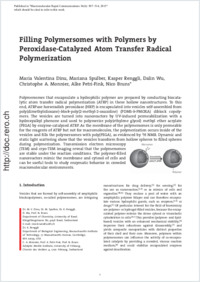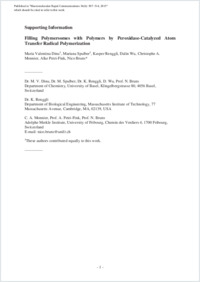Filling polymersomes with polymers by peroxidase-catalyzed atom transfer radical polymerization
- Dinu, Maria Valentina Department of Chemistry, University of Basel, Switzerland
- Spulber, Mariana Department of Chemistry, University of Basel, Switzerland
- Renggli, Kasper Department of Chemistry, University of Basel, Switzerland - Department of Biological Engineering, Massachusetts Institute of Technology, Cambridge, MA, USA
- Wu, Dalin Department of Chemistry, University of Basel, Switzerland
- Monnier, Christophe A. Adolphe Merkle Institute, University of Fribourg, Switzerland
- Petri-Fink, Alke Adolphe Merkle Institute, University of Fribourg, Switzerland
- Bruns, Nico Department of Chemistry, University of Basel, Switzerland - Adolphe Merkle Institute, University of Fribourg, Switzerland
-
01.03.2015
Published in:
- Macromolecular Rapid Communications. - 2015, vol. 36, no. 6, p. 507–514
amphiphilic block copolymer vesicles
atom transfer radical polymerization (ATRP)
biocatalysis
bio-inspiration
nanoreactors
English
Polymersomes that encapsulate a hydrophilic polymer are prepared by conducting biocatalytic atom transfer radical polymerization (ATRP) in these hollow nanostructures. To this end, ATRPase horseradish peroxidase (HRP) is encapsulated into vesicles self-assembled from poly(dimethylsiloxane)-block-poly(2-methyl-2-oxazoline) (PDMS-b-PMOXA) diblock copolymers. The vesicles are turned into nanoreactors by UV-induced permeabilization with a hydroxyalkyl phenone and used to polymerize poly(ethylene glycol) methyl ether acrylate (PEGA) by enzyme-catalyzed ATRP. As the membrane of the polymersomes is only permeable for the reagents of ATRP but not for macromolecules, the polymerization occurs inside of the vesicles and fills the polymersomes with poly(PEGA), as evidenced by 1H NMR. Dynamic and static light scattering show that the vesicles transform from hollow spheres to filled spheres during polymerization. Transmission electron microscopy (TEM) and cryo-TEM imaging reveal that the polymersomes are stable under the reaction conditions. The polymer-filled nanoreactors mimic the membrane and cytosol of cells and can be useful tools to study enzymatic behavior in crowded macromolecular environments.
- Faculty
- Faculté des sciences et de médecine
- Department
- Département de Chimie, AMI - Chimie des polymères et matériaux
- Language
-
- English
- Classification
- Chemistry
- License
-
License undefined
- Identifiers
-
- RERO DOC 255796
- DOI 10.1002/marc.201400642
- Persistent URL
- https://folia.unifr.ch/unifr/documents/304238
Other files
Statistics
Document views: 101
File downloads:
- pdf: 301
- Supplementary material: 131

